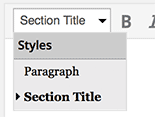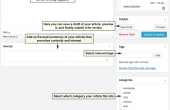Five Pointers To Get Started
1. What is The Artifice?
The Artifice is an online magazine that covers a wide spectrum of art forms. We do not run The Artifice, you do. The Artifice is collaboratively built and maintained by your fellow writers.
The platform is designed to reward you based on how you interact with it and its users. Once the system learns to trust you, you will be able to manage everything, much like Wikipedia.
Our current writers range from undergraduates to emeritus professors.
Like our official Facebook fan page and follow us on Twitter. Do not forget to subscribe to our RSS Feed.
We have opened a special Facebook page for writers. Please go here, click on the “Like” button, and do not forget to tick the “Get Notifications” option.
You can also find us on reddit.
2. What type of content can you write here?
There is a difference in the type of content we can publish here and what works in a blog format. This is not a blog. Aim to make your article an educated discussion rather than an opinion piece. As a writer you must have the ability to explain ideas with a coherent variety of appropriate language.
We distance ourselves from the trend of republishing the same stories (latest entertainment news etc.) and instead focus on topics that are intellectually stimulating and meaningful.
A common issue among our new writers is selecting the right topic to explore. Your first article should be a topic that you are most knowledgeable about. Here at The Artifice, knowledge and passion are as important as the quality of the writing.
With your first article, you want to demonstrate the depth of your knowledge and expertise in your niche. Our writing community is very eager to find out where you will fit in.
Your first submission cannot be a review article.
There are many other types of articles that you can choose. For example, you may be interested in writing a comprehensive list of Major Plot Points to Anticipate in The Winds of Winter, a study about Why we love the TV show Downton Abbey, and what this love suggest about ourselves, a creative exploration of What can be learned by suffering through the brutality of the movie Martyrs, an in-depth view of the Politics and Privilege in the animation The Legend of Korra, a retrospective look at The History of Comics, a tribute to The Bryan Fuller Fantasy, or maybe a less comprehensive but yet intriguing investigation of The Blacklisting of Michael Parks.
Writing Style and Point of View
Writers beware. This is not a platform to dump academic essays, nor is it a place for your personal blog.
What kind of mood should your article set? There are two extremes to be wary of: the graduate thesis and the blog entry. Our objective is to occupy neither. Instead, we want your article to occupy a comfortable location in between these two extremes in order to maximize the number of readers and preserve a professional atmosphere throughout the site.
To keep your article from appearing too much like a graduate thesis, make sure to define complex words and adequately describe complicated ideas. This allows readers to feel comfortably immersed into your area of expertise. The goal is not to simplify your complex ideas, but rather to make them comprehensible for readers who may not be familiar with your topic. The common denominator that connects high-caliber articles here at The Artifice is the ability to display educated perspectives while appealing to a wide audience.
To keep your article from appearing like a blog entry, avoid writing needlessly in the first person, especially during your trial period. Instead, utilize the third person voice in your article wherever possible. Although it might seem counterintuitive, you can write an article that implies your own perspective without writing in the first person. Consider the examples below.
Written in the first person:
Although I’ve noticed slasher films making a comeback in the last few years, the cinematic quality just isn’t there in my opinion.”
“The musical ensemble initially struck me as overly dramatic, but I eventually embraced the recurring leitmotif, as it filled an aesthetic void in the film.”
Written in the third person:
“Although slasher films have made a comeback in the last few years, their cinematic quality hasn’t been as eager to resurge.”
“The musical ensemble initially strikes one as overly dramatic, but an attentive viewer will eventually embrace the recurring leitmotif, as it fills an aesthetic void in the film.”
Both sets of sentences advance the same general ideas, but the ones written in the third person appear more professional while also implicitly describing the perspective of the author. This technique can also add to the authority of a sentence by making it seem as though the idea extends to a larger range of people instead of just the author.
It is important to note that there are always exceptions to the rules, especially in written work. Some writers can effectively pull off the first person voice without detracting from an article, and some ideas can only be adequately expressed by writing in the first person. But in your first three articles, it is strongly advised that you restrict yourself to the third person voice, as this is a standard that we do enforce when processing submissions.
3. Posting your first article
While not a requirement, for your first article, it is recommended to grab one of the Topics listed.
You can create a new article by hovering your cursor over the Posts on the top-bar menu and then New Post.
You will then enter the post edit page; the following image summarizes the layout (click to enlarge):
As of May 2015, the Excerpt field has been removed.
Title
Choose a title that clearly defines the content of your article. Narrows it down to the very points you are exploring.
Capitalise your article title. Follow these rules:
- Capitalise the principal words, including prepositions and conjunctions of four or more letters.
- Capitalise an article–the, a, an–or words of fewer than four letters if it is the first or last word in a title.
Uploading Image
To upload and insert files, click on the Add Media button. Once you have uploaded your image, you can select the image size you want to insert into your article. Selecting the wrong image size is a very common mistake that our writers do.
We recommend you select the “Medium” or “Large cropped” size. Learn more about image sizes in the guide.
When you upload an image, please add a title and a description that briefly explains the subject of the image.
Only images in the JPG format are allowed.
Featured Image
Every article is required to have a featured image attached to it. The image must be at least 300 pixels wide.
Tags
Each article is required to have at least 3 tags and no more than 5. Make sure to select relevant tags for your article. For example, if your article is a study about “Psycho”, then the tags “Psycho”, “Study”, “Horror”, and “Alfred Hitchcock” would be appropriate.
Do not add the category name as a tag.
Formatting
Any article that is not properly formatted according to the guidelines will not be published.
Format your text properly. Set the body text as “Paragraph” and your section titles as “Section Title”. To format your text, highlight the body text or title with your cursor and then make your choice in the Visual Editor:

Make titles italic. Make any title (of books, movies, television shows etc) that you include in your body text italic.
Only insert images that add a value to the content of your article.
Insert at least one image into your article. If your article is in list format, insert one image for each list entry.
Select the size of your images with care and align them correctly.
Do not rescale an image.
If your article is a list, make the numbers a countdown to the final entry. For example, if you have a list of 10 entries, make the top entry the 10th one, and the final entry 1st.
Separate your content into normal length paragraphs to avoid it being cramped into chunks of text.
Preview your article before submitting it for review. At the top right box, you can find the Preview button.
4. Editorial Process
When you submit your article for review, it will be available for processing by all members of The Artifice. Users can either cast an approval or a revision vote. Each vote adds or deducts points to a score that will need to reach the value of 6 before the article will be considered for publication.
Once your post is in pending mode, you will need to monitor it for revision votes. If it does receive a revision entry, you will need to address the revision and mark it as fixed. Note that your article will never be published if there is an unfixed revision entry.
Also, if there are any comments posted to a revision entry, make sure to read through them, there may be further revision notes posted there.
If you disagree with a revision entry, you will still need to mark the revision as fixed. Just ensure to leave a comment detailing why you disagree with the feedback.
5. Points, Rank and Ratio
You can accumulate points on the basis of your achievements to advance through a series of hierarchical levels, each of which entails access to new perks and heightened prestige.
You will collect small bounties of points for various accomplishments, such as posting a comment, receiving a comment, having your article featured, and much more.
Also, being on a higher rank will allow you to have your articles highlighted across the platform.
The Artifice is a collaborative platform where we encourage you to provide feedback to your fellow writers as much as publishing your own articles. To maintain a fair share of feedback, we have added a ratio system. All you need is to post comments, submit topics, leave helpful notes, and process other writers’ articles more than the total amount of your own published articles.
While you are allowed to submit articles while having a low ratio, we may not feature it with respect to writers who maintain a good ratio.
Learn more about this in the guide.
So in short, to gain points, rank up and maintain a good ratio, all you need to do is to use this platform as a collaborative space where you engage with your fellow writers.
